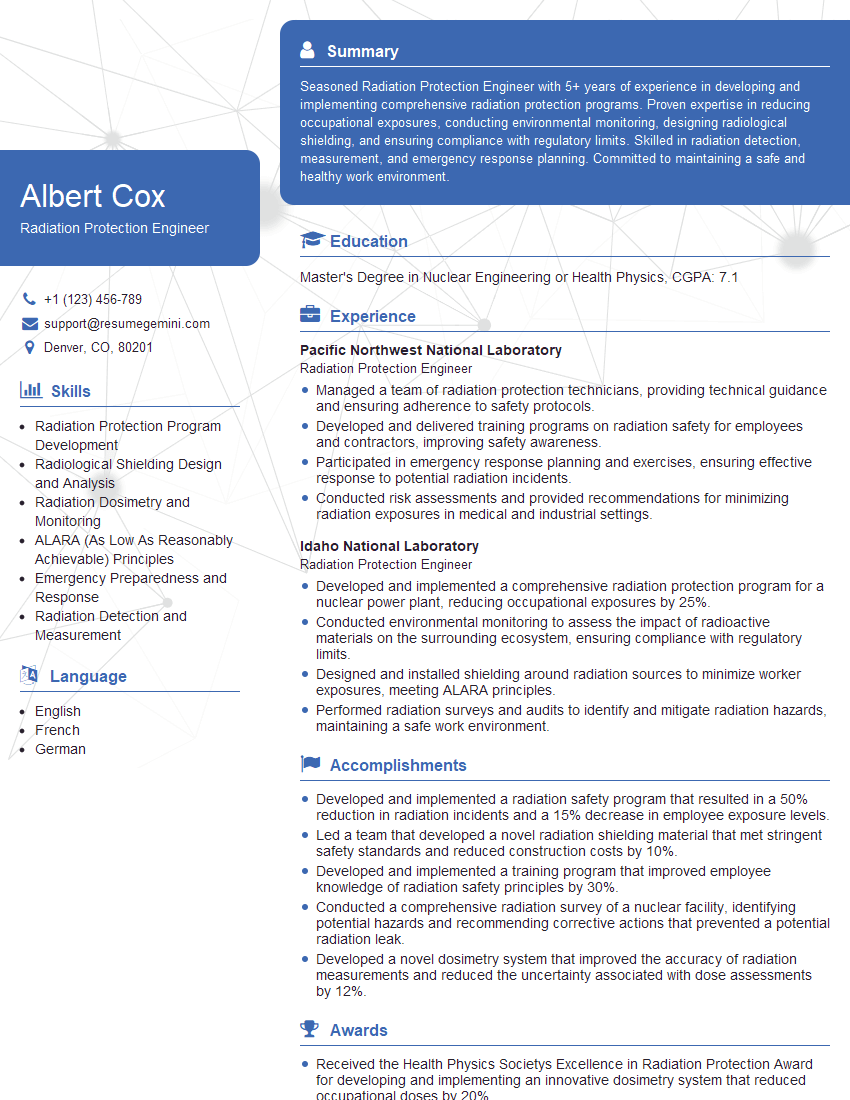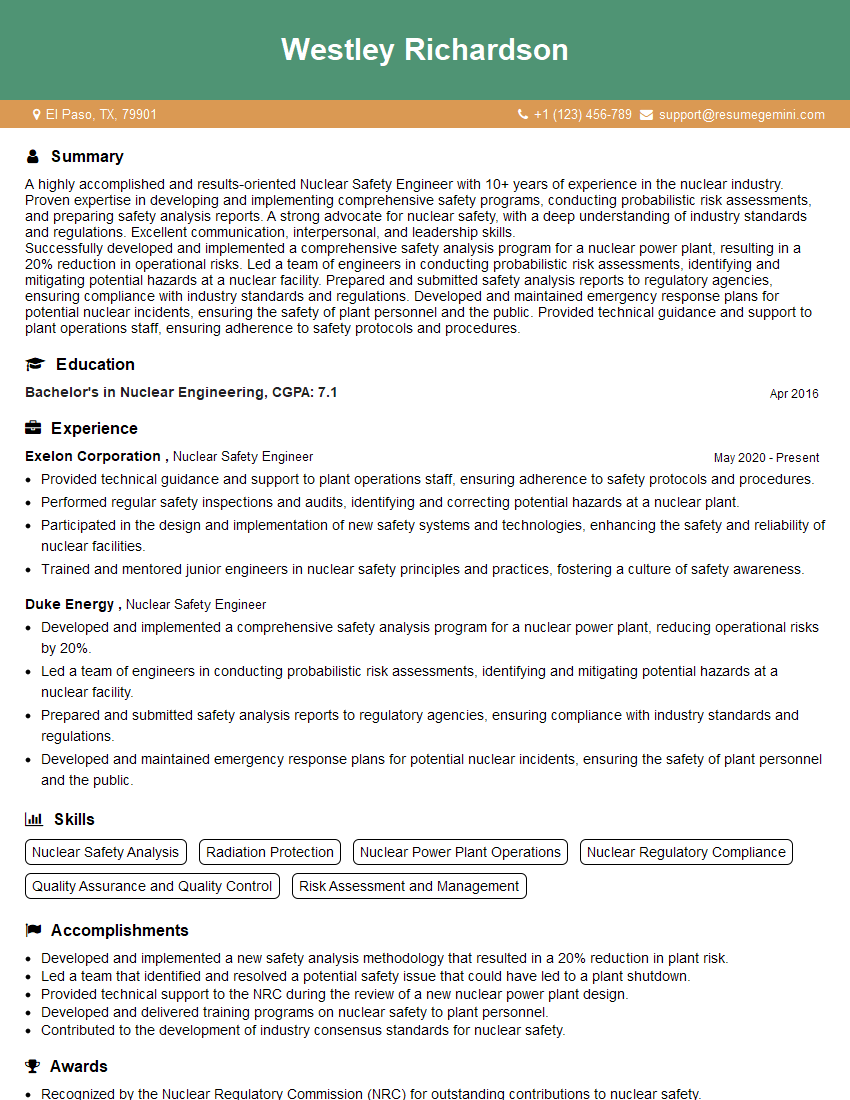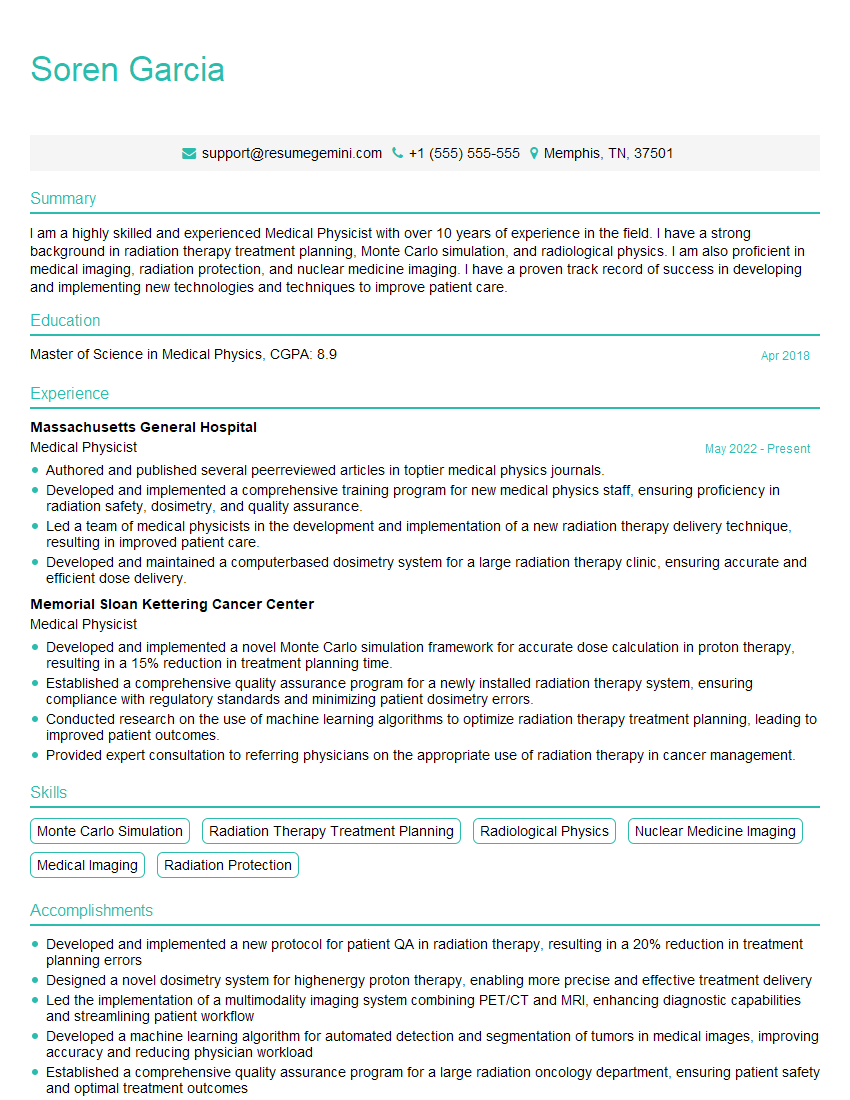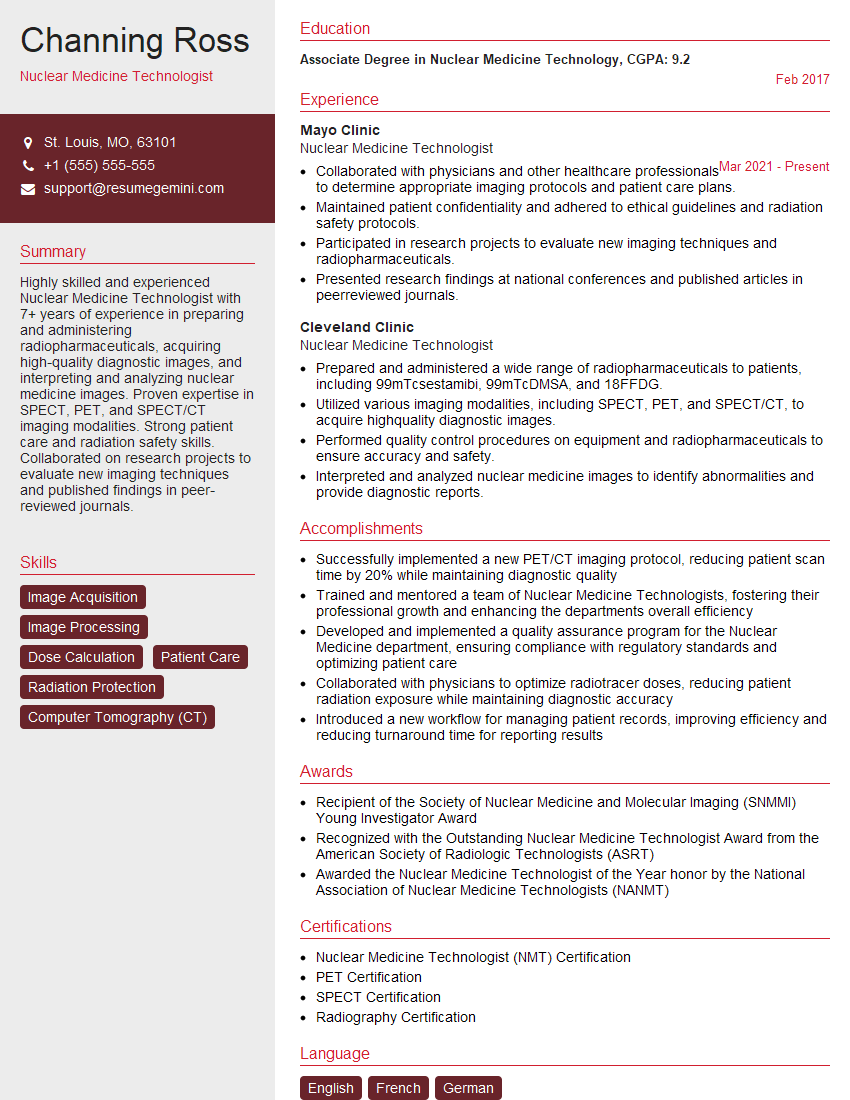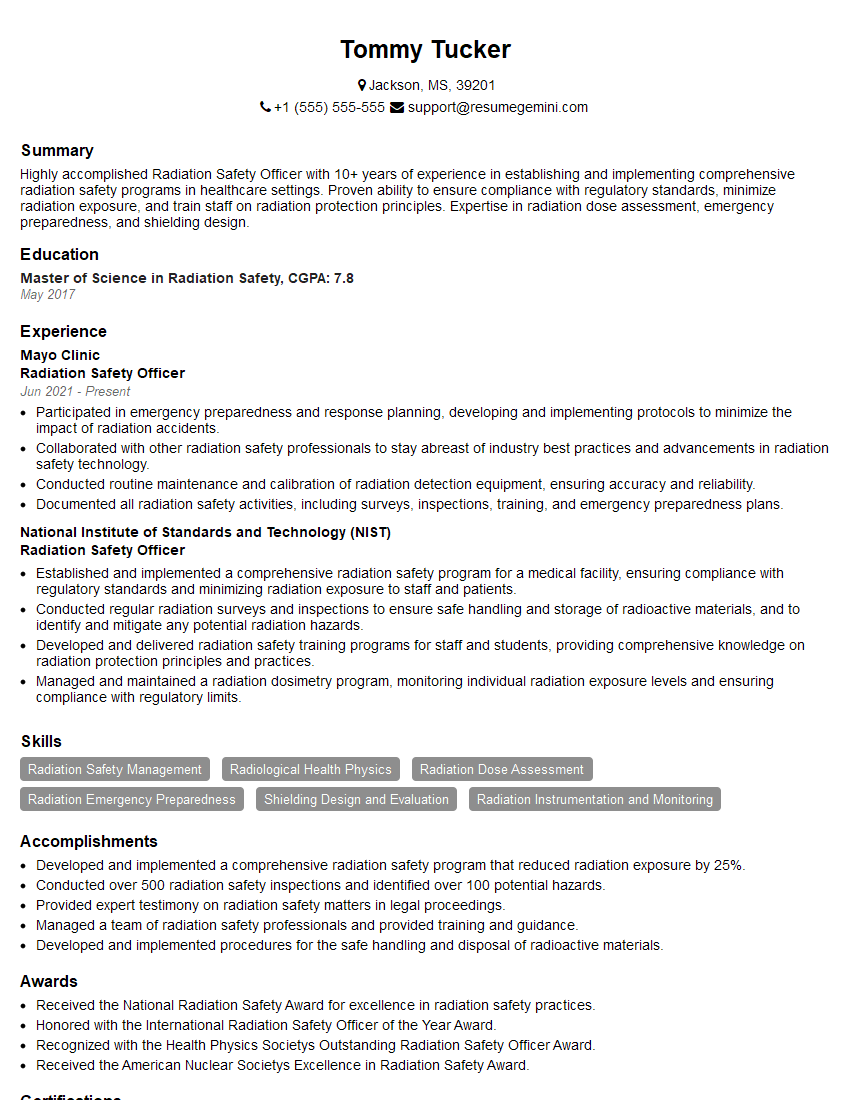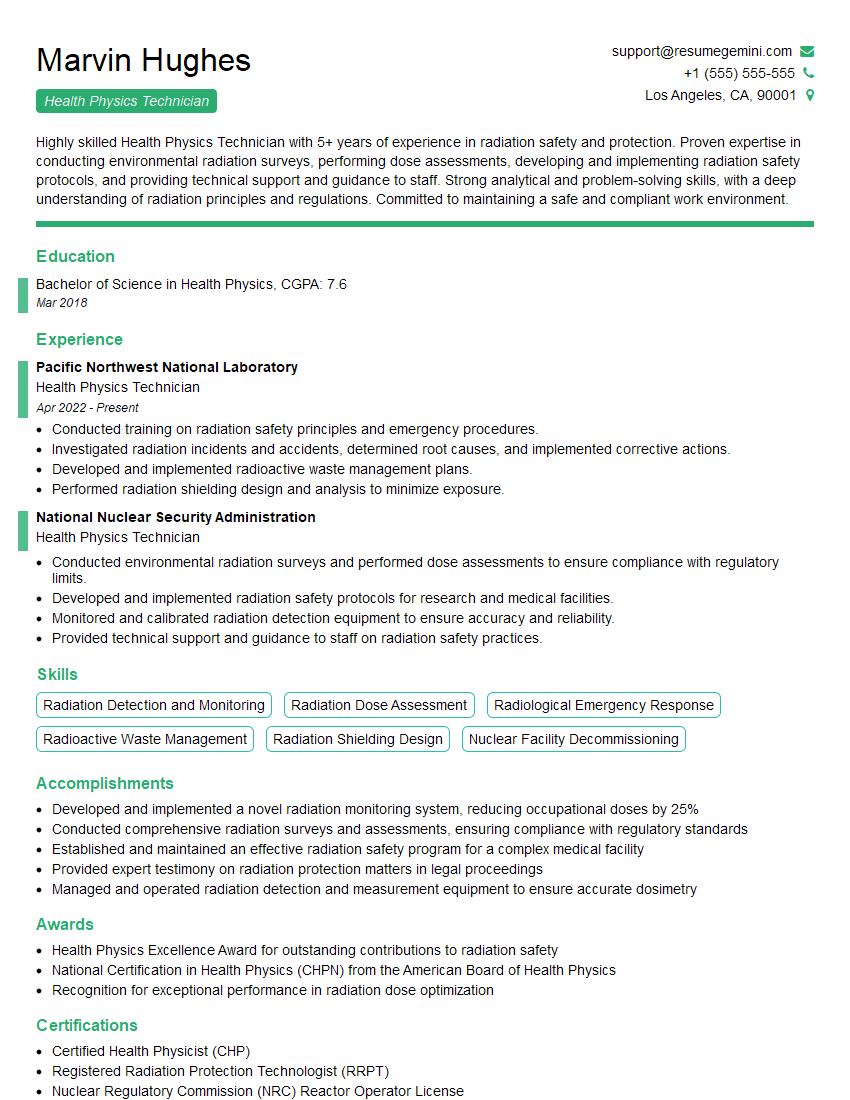Cracking a skill-specific interview, like one for Radiation Protection Planning, requires understanding the nuances of the role. In this blog, we present the questions you’re most likely to encounter, along with insights into how to answer them effectively. Let’s ensure you’re ready to make a strong impression.
Questions Asked in Radiation Protection Planning Interview
Q 1. Explain the ALARA principle and its application in radiation protection.
The ALARA principle, short for “As Low As Reasonably Achievable,” is a fundamental cornerstone of radiation protection. It dictates that all exposures to ionizing radiation should be kept as far below regulatory limits as is reasonably achievable, taking into account economic and social factors. This isn’t about eliminating all radiation exposure – that’s often impractical – but about minimizing unnecessary exposure.
In practice, ALARA guides the development and implementation of radiation safety programs. It involves a multi-pronged approach:
- Time: Minimizing the time spent in a radiation field. For example, a radiographer will limit their time near an X-ray machine during exposures.
- Distance: Increasing the distance from the radiation source significantly reduces exposure, as radiation intensity follows an inverse square law. A technician working with radioactive materials will use remote handling tools whenever possible.
- Shielding: Using appropriate shielding materials (lead, concrete, etc.) to absorb radiation. Lead aprons are a prime example of shielding used in medical radiology.
Consider a hospital’s nuclear medicine department. ALARA dictates that they optimize their shielding design to minimize radiation leakage, use efficient procedures to reduce the time patients are exposed, and ensure all staff use appropriate personal protective equipment. The principle is not just about safety but also efficiency – minimizing wasted time and resources.
Q 2. Describe the different types of ionizing radiation and their relative biological effectiveness.
Ionizing radiation, capable of removing electrons from atoms, comes in several forms, each with different biological effectiveness:
- Alpha particles: Heavy, positively charged particles with high ionization density. They have a short range in air but are highly damaging if ingested or inhaled (high Relative Biological Effectiveness or RBE). Think of them as a heavy truck crashing into a building – immense localized damage.
- Beta particles: Lighter, negatively or positively charged particles with a longer range than alpha particles and moderate ionization density. Their RBE is lower than alpha particles. Imagine them as cars driving into the same building – damage is less severe.
- Gamma rays and X-rays: Electromagnetic radiation with no mass or charge. They have a long range and low ionization density, causing less localized damage but potentially impacting a larger area. Their RBE is considered to be 1.
- Neutrons: Uncharged particles that interact indirectly with matter, leading to the production of other types of ionizing radiation. Their RBE varies greatly depending on their energy.
Relative Biological Effectiveness (RBE) compares the biological effect of different types of radiation relative to a reference radiation (usually gamma rays or X-rays). A higher RBE means a type of radiation is more biologically damaging at the same dose. The RBE for alpha particles can be as high as 20, meaning that a dose of 1 Gy of alpha particles has the same biological effect as 20 Gy of gamma rays.
Q 3. What are the key components of a radiation protection program?
A comprehensive radiation protection program encompasses several key components:
- Radiation safety officer (RSO): A designated individual responsible for overseeing the program.
- Written procedures: Detailed operational procedures for handling radioactive materials and equipment.
- Training and education: Regular training for all personnel working with radiation sources.
- Monitoring and assessment: Regular monitoring of radiation levels and personnel doses.
- Emergency preparedness: Procedures for responding to radiation accidents or spills.
- Record-keeping: Detailed records of radiation exposures, instrument calibrations, and maintenance.
- Waste management: Safe and compliant handling and disposal of radioactive waste.
For instance, a research laboratory using radioactive isotopes would have strict protocols for handling samples, regular area monitoring, and designated waste containers to ensure compliance with all relevant regulations. A well-defined program anticipates potential hazards and implements measures to proactively mitigate risks.
Q 4. How do you calculate radiation dose?
Radiation dose calculation depends on the type of radiation and the unit used. The fundamental unit is the Gray (Gy), which measures the absorbed dose of energy deposited in a material. The Sievert (Sv) is used to measure equivalent dose and effective dose, accounting for the different biological effects of various radiation types.
Absorbed dose (in Gy) = Energy absorbed (Joules) / Mass (kilograms)
Equivalent dose (in Sv) = Absorbed dose (Gy) x Radiation weighting factor (WR)
The radiation weighting factor (WR) is a dimensionless factor that accounts for the biological effectiveness of different radiation types (e.g., WR = 1 for gamma rays, WR = 20 for alpha particles).
Effective dose (in Sv) = Sum of (Equivalent dose to organ/tissue (Sv) x Tissue weighting factor (WT))
The tissue weighting factor (WT) accounts for the varying sensitivity of different organs and tissues to radiation. It is a dimensionless value assigned to different organs and tissues (e.g., WT = 0.12 for the lungs, WT = 0.05 for the skin).
For example, if a person receives 0.1 Gy of gamma radiation to the lungs, the equivalent dose is 0.1 Sv (0.1 Gy x 1), and the effective dose is 0.012 Sv (0.1 Sv x 0.12).
Q 5. Explain the concept of effective dose and its significance.
Effective dose is a measure of the overall health risk from exposure to ionizing radiation. Unlike absorbed dose, it accounts for the type and location of radiation exposure, considering the different sensitivities of various organs and tissues in the body. It’s expressed in Sieverts (Sv).
The significance lies in its ability to provide a single quantity that represents the potential harm from a whole-body or partial-body radiation exposure. It allows radiation protection professionals to assess the overall health risk and compare the potential effects of various exposure scenarios. Regulations and dose limits are often expressed in terms of effective dose.
For example, a 1 Sv effective dose to the whole body represents a significantly greater risk than a 1 Sv absorbed dose to a single finger. This is because the effective dose takes into account the different organ weighting factors and the relative sensitivity of each tissue. It provides a more realistic measure of the overall health risk.
Q 6. What are the regulatory requirements for radiation safety in your area?
Regulatory requirements for radiation safety vary significantly by location. However, general principles and many specific requirements are often harmonized internationally. In many jurisdictions, regulations are based on the recommendations of the International Commission on Radiological Protection (ICRP) and enforced by national or regional bodies. These regulations typically cover:
- Licensing of radiation sources: Obtaining the necessary permits and licenses for possessing or using radiation sources.
- Dose limits: Establishing limits for occupational and public exposures to ionizing radiation.
- Monitoring requirements: Regulations on radiation monitoring procedures (environmental and personal).
- Record-keeping: Requirements for maintaining detailed radiation exposure records.
- Emergency planning: Protocols for responding to radiation incidents and accidents.
- Waste disposal: Regulations on the disposal of radioactive waste and materials.
Specific regulations will depend on the type of radiation source used and the application, for example, medical, industrial or research. It is crucial to consult and adhere to the specific legal requirements in one’s specific area of operation.
Q 7. Describe different types of radiation detection instruments and their uses.
Numerous instruments are used for radiation detection, each with specific applications:
- Geiger-Müller (GM) counters: Widely used for detecting beta and gamma radiation. They are simple, relatively inexpensive, and provide a quick indication of radiation levels. Often used for rapid surveys.
- Scintillation detectors: Highly sensitive detectors used for measuring various types of radiation, including alpha, beta, and gamma. They provide quantitative measurements of radiation levels.
- Ionization chambers: Used for accurate measurements of gamma radiation exposure rates. They are generally less sensitive than GM counters or scintillation detectors but are highly reliable and stable. Often used for radiation calibration.
- Proportional counters: Similar to GM counters but can differentiate between different types of radiation. They provide more detailed information than GM counters but are more complex to operate.
- Personal dosimeters (e.g., thermoluminescent dosimeters (TLDs), optically stimulated luminescence (OSL) dosimeters): These are worn by radiation workers to measure their individual exposure to ionizing radiation over a period of time. They provide a permanent record of exposure.
For example, a nuclear power plant might employ a combination of GM counters for rapid surveys, scintillation detectors for more precise measurements, and ionization chambers for area monitoring. A medical facility would use GM counters or scintillation detectors for radiation leak checks and personal dosimeters for staff radiation monitoring.
Q 8. Explain the process of conducting a radiation survey.
A radiation survey is a systematic process of measuring radiation levels in a specific area to identify and quantify potential radiation hazards. It’s like taking the temperature of a room, but instead of measuring heat, we’re measuring radiation.
The process typically involves:
- Planning: Defining the scope of the survey, including the area to be surveyed, the types of radiation to be measured (alpha, beta, gamma, neutron), and the required accuracy.
- Instrument Selection: Choosing appropriate radiation detection instruments based on the type and energy of radiation expected. This might include Geiger-Müller counters, scintillation detectors, or survey meters.
- Measurement: Systematically measuring radiation levels at various points within the defined area. This often involves following a predetermined grid pattern or focusing on areas of suspected higher radiation.
- Data Recording: Accurately recording the measured radiation levels, along with the location and time of each measurement. This usually involves detailed mapping and logging of readings.
- Analysis: Interpreting the collected data to identify areas of high radiation, assess potential risks, and determine if any corrective actions are necessary.
- Reporting: Preparing a comprehensive report that summarizes the survey findings, including maps showing radiation levels, conclusions, and recommendations.
Example: A radiation survey might be conducted before demolition of an old hospital to assess the presence of residual radioactivity from past medical procedures, allowing for appropriate safety precautions to be taken during the demolition.
Q 9. How do you assess the risk of radiation exposure?
Assessing radiation risk involves estimating the probability and severity of harmful health effects from exposure to ionizing radiation. We don’t just measure the radiation; we translate that measurement into a potential health impact.
This assessment considers several factors:
- Type and energy of radiation: Alpha particles, for instance, are more damaging if ingested than external gamma rays.
- Radiation dose: The amount of radiation absorbed by the body, measured in units like Sieverts (Sv) or millisieverts (mSv). This is a critical factor.
- Exposure duration: A high dose over a short period is more hazardous than the same total dose spread over a longer time.
- Exposure pathway: How the radiation enters the body (inhalation, ingestion, external exposure).
- Sensitivity of the exposed individuals: Children and pregnant women are more vulnerable than adults.
Risk assessment often utilizes dose-response models and risk coefficients to translate the absorbed dose into probabilities of developing specific health effects, such as cancer or genetic mutations. Regulatory limits and guidelines are based on these risk assessments to ensure that exposures remain acceptably low.
Example: A nuclear power plant needs to assess the risk to workers from routine operations and during maintenance, considering potential exposure from various sources like spent fuel or contaminated tools. They use sophisticated models and radiation monitoring to keep the risk far below acceptable limits.
Q 10. What are the different methods of radiation shielding?
Radiation shielding aims to reduce the amount of radiation reaching individuals or equipment. The effectiveness depends on the type of radiation and the shielding material.
Methods include:
- Distance: The intensity of radiation decreases rapidly with distance from the source (inverse square law). This is the simplest and often most effective method.
- Time: Minimizing the time spent in a radiation field reduces the total dose received.
- Shielding materials: Different materials offer varying degrees of protection.
- Dense materials: Lead, concrete, and steel are effective against gamma and X-rays. The denser the material, the better the shielding.
- Hydrogenous materials: Water, polyethylene, and paraffin are good for shielding neutrons.
Example: Lead aprons are used by radiologists to shield their bodies from X-ray exposure during medical procedures. Thick concrete walls surround nuclear reactors to shield the environment from gamma radiation.
Q 11. Describe the principles of contamination control.
Contamination control focuses on preventing the spread of radioactive material to people, the environment, or equipment. It’s about containing the spill and preventing it from becoming a widespread problem.
Key principles include:
- Containment: Restricting the movement of radioactive material through physical barriers like sealed containers, controlled areas, and absorbent materials.
- Isolation: Separating contaminated items from uncontaminated ones to prevent cross-contamination.
- Decontamination: Removing radioactive material from surfaces or objects through methods like washing, scrubbing, or chemical treatments.
- Waste management: Proper disposal or treatment of contaminated materials to minimize environmental impact.
- Personal Protective Equipment (PPE): Using appropriate PPE like gloves, respirators, and protective clothing to prevent contamination of personnel.
- Training and procedures: Implementing robust procedures and training programs to ensure that personnel are aware of contamination risks and follow appropriate safety protocols.
Example: A spill of radioactive liquid in a laboratory requires immediate containment using absorbent pads, isolation of the affected area, and decontamination of affected surfaces and personnel.
Q 12. What are the emergency procedures in case of a radiation accident?
Emergency procedures for radiation accidents prioritize the safety of personnel and the environment. They’re designed to minimize exposure and prevent further spread of contamination.
These typically include:
- Immediate actions: Evacuation of personnel from the affected area, assessment of the situation, and implementation of emergency response plans.
- Contamination control: Controlling the spread of radioactive material through containment, isolation, and decontamination measures.
- Medical treatment: Providing appropriate medical care to injured or exposed individuals. This often involves decontamination and treatment for radiation sickness.
- Environmental monitoring: Assessing the extent of environmental contamination and taking measures to mitigate its impact.
- Notification: Notifying relevant authorities (e.g., emergency services, regulatory agencies) and the public as appropriate.
- Post-accident investigation: Conducting a thorough investigation to determine the cause of the accident and identify measures to prevent similar incidents in the future.
Example: A nuclear power plant emergency response plan would detail procedures for evacuating nearby populations, controlling radioactive releases, and providing medical treatment in case of an accident. Regular drills and training ensure preparedness.
Q 13. Explain the importance of personal protective equipment (PPE) in radiation protection.
Personal Protective Equipment (PPE) is crucial in radiation protection, acting as a barrier between the individual and the radiation source or contaminated materials.
The type of PPE used depends on the specific hazard:
- Lead aprons and gloves: Protect against X-rays and gamma radiation.
- Respirators: Prevent inhalation of airborne radioactive particles.
- Protective clothing: Prevents contamination of skin and clothing.
- Protective footwear: Protects feet from contamination.
- Eye protection: Protects eyes from radiation and splashes of radioactive material.
PPE must be properly selected, fitted, used, and maintained to ensure effectiveness. Regular inspection and replacement are essential to maintain its protective capabilities.
Example: Nuclear power plant workers wear specialized protective suits and respirators when handling radioactive materials to minimize potential exposure. Medical personnel use lead aprons and gloves during X-ray procedures.
Q 14. How do you manage radioactive waste?
Radioactive waste management involves the safe handling, storage, and disposal of radioactive materials to prevent environmental and human exposure. It’s a multi-stage process with significant regulatory oversight.
Key aspects include:
- Classification: Categorizing waste based on its radioactivity level and physical form (e.g., liquid, solid). This determines the appropriate treatment and disposal method.
- Treatment: Reducing the volume and radioactivity of waste through methods like incineration, solidification, and chemical treatment.
- Storage: Temporarily storing waste in secure facilities until a permanent disposal solution is available. This often involves specialized containers and monitoring systems.
- Disposal: Disposing of waste in a manner that ensures long-term isolation from the environment. This might involve shallow land burial, deep geological repositories, or other specialized methods depending on the waste category.
- Monitoring: Continuous monitoring of waste storage and disposal sites to detect and prevent any leaks or environmental contamination.
Example: Spent nuclear fuel from power plants is typically stored in on-site pools for several years before being transferred to dry cask storage awaiting a permanent geological repository. Low-level radioactive waste may be disposed of in specially licensed landfills.
Q 15. What are the legal and ethical responsibilities of a radiation protection professional?
The legal and ethical responsibilities of a radiation protection professional are paramount, aiming to ensure the safety and well-being of individuals and the environment. Legally, we’re bound by national and international regulations, which vary by country but generally focus on minimizing radiation exposure to As Low As Reasonably Achievable (ALARA) levels. This includes adhering to licensing requirements, reporting incidents, and maintaining accurate records. Ethically, our core responsibility is to act with integrity, placing the safety of others above all else. This involves providing objective advice, even when it conflicts with economic pressures, ensuring transparency in our work, and maintaining confidentiality where appropriate. For instance, if I detected a significant radiation leak in a facility, my legal obligation is to report it immediately, while my ethical obligation demands I do so responsibly, considering potential public panic and providing clear, factual information.
Career Expert Tips:
- Ace those interviews! Prepare effectively by reviewing the Top 50 Most Common Interview Questions on ResumeGemini.
- Navigate your job search with confidence! Explore a wide range of Career Tips on ResumeGemini. Learn about common challenges and recommendations to overcome them.
- Craft the perfect resume! Master the Art of Resume Writing with ResumeGemini’s guide. Showcase your unique qualifications and achievements effectively.
- Don’t miss out on holiday savings! Build your dream resume with ResumeGemini’s ATS optimized templates.
Q 16. Describe the process of developing a radiation safety plan.
Developing a radiation safety plan is a systematic process. It begins with a thorough assessment of potential radiation sources and hazards within the facility. This involves identifying all radiation-emitting equipment, materials, and processes, then characterizing their radiation output. Next, we identify individuals who might be exposed and assess the potential pathways of exposure – inhalation, ingestion, external exposure. Based on this risk assessment, we establish controls to minimize exposure. These could include engineering controls like shielding, administrative controls like work practices and access restrictions, and personal protective equipment (PPE) such as lead aprons and dosimeters. The plan should include emergency procedures, training programs for personnel, and a system for monitoring radiation levels and worker doses. Regular reviews and updates are crucial to ensure the plan’s continued effectiveness. Imagine developing a plan for a hospital; we’d need to account for X-ray machines, radiotherapy units, and radioactive pharmaceuticals, tailoring controls to each specific area and potential exposure pathway.
Q 17. How do you ensure compliance with radiation safety regulations?
Ensuring compliance involves a multi-pronged approach. First, we establish a strong safety culture within the organization, emphasizing the importance of radiation safety at all levels. Regular training and communication are vital in this. We implement a robust monitoring program, using various dosimeters to track worker exposure, and environmental monitoring equipment to measure radiation levels in the workplace. We meticulously maintain records, documenting all radiation-related activities and any deviations from established procedures. Internal audits are conducted regularly to identify areas for improvement. Furthermore, we actively engage with regulatory bodies, ensuring timely submission of reports and cooperating fully with inspections. Non-compliance can lead to serious consequences, including fines, license suspension, or even legal action. For example, consistently exceeding dose limits for personnel would trigger immediate action, requiring a thorough investigation and corrective measures.
Q 18. Explain the concept of dose rate and its relationship to dose.
Dose rate refers to the amount of radiation absorbed per unit of time, typically measured in units like Sieverts per hour (Sv/h) or milliSieverts per hour (mSv/h). Dose, on the other hand, represents the total amount of radiation absorbed over a specific period. The relationship is simple: dose = dose rate x time. For example, if a worker is exposed to a dose rate of 0.1 mSv/h for 10 hours, their total dose would be 1 mSv (0.1 mSv/h * 10h = 1 mSv). Understanding this relationship is crucial for calculating cumulative exposure and managing occupational radiation safety effectively. Think of filling a water tank: the dose rate is the flow rate, and the dose is the total volume of water in the tank after a certain time. The faster the flow (dose rate), the quicker the tank fills (higher dose).
Q 19. What are the biological effects of radiation exposure?
The biological effects of radiation exposure depend on several factors: the type and energy of radiation, the dose received, and the duration of exposure. At low doses, the effects are primarily stochastic, meaning the probability of an effect increases with dose but the severity is independent of the dose. This includes an increased risk of cancer and genetic mutations. At high doses, the effects are deterministic, meaning the severity of the effect increases with dose. These include radiation sickness (nausea, vomiting, fatigue), skin burns, and damage to the blood-forming organs. The severity of these effects can range from mild to fatal, depending on the dose received. For instance, a high dose from acute exposure could lead to immediate illness, while lower, chronic exposure might lead to a delayed increase in cancer risk decades later. It’s crucial to remember that even low doses are not entirely without risk, hence the ALARA principle.
Q 20. Describe the different types of dosimeters and their limitations.
Several types of dosimeters are used for radiation monitoring. Film badges are passive devices that change color depending on the amount of radiation they receive. They are relatively inexpensive but have limited accuracy and a relatively high detection threshold. Thermoluminescent dosimeters (TLDs) are small crystals that store energy from radiation exposure and release it as light when heated. TLDs offer better accuracy and sensitivity than film badges. Electronic personal dosimeters (EPDs) measure radiation in real-time, providing immediate feedback to the wearer. However, they’re more expensive and require regular calibration. All dosimeters have limitations. Film badges fade over time, affecting accuracy. TLDs have a limited dynamic range. EPDs can be affected by environmental factors and may require frequent battery replacements. The choice of dosimeter depends on the specific application and the level of accuracy required. For example, a construction worker near a low-level source might wear a film badge, whereas a nuclear medicine technician might use an EPD.
Q 21. How do you interpret dosimetry results?
Interpreting dosimetry results involves comparing the measured dose to established limits and regulations. First, we verify the accuracy and completeness of the data, checking for any inconsistencies or artifacts. Then we calculate the effective dose, considering the type and energy of radiation and the organs exposed. This dose is compared to regulatory limits for occupational exposure, typically set by national authorities. Exceeding these limits triggers investigations to identify the cause and implement corrective actions. We also analyze trends over time to identify potential patterns and assess the effectiveness of radiation protection measures. The interpretation always considers the context – the type of work, duration of exposure, and any other contributing factors. A high reading on a dosimeter doesn’t automatically imply a serious problem; it triggers further investigation to determine the cause and whether any remedial action is necessary.
Q 22. What are the different methods of radiation monitoring?
Radiation monitoring employs various methods to assess radiation levels and ensure safety. These methods can be broadly categorized into area monitoring, which measures radiation levels in a specific location, and personal monitoring, which tracks individual exposure.
- Area Monitoring: This involves using fixed or portable instruments like Geiger-Müller counters, ionization chambers, and scintillation detectors to measure ambient radiation levels. For example, a Geiger counter might be placed near a nuclear reactor to continuously monitor radiation leakage.
- Personal Monitoring: This utilizes devices like thermoluminescent dosimeters (TLDs) or film badges worn by individuals working with radiation sources. These devices record the cumulative radiation dose received over a period, providing a personal exposure record. Imagine a radiologist wearing a film badge to track their exposure during X-ray procedures.
- Environmental Monitoring: This broader approach includes sampling air, water, and soil to determine the presence and levels of radioactive materials. This is crucial in assessing environmental impact following a nuclear accident, for instance, by measuring radioactive isotopes in the soil near a contaminated site.
The choice of monitoring method depends on the type and level of radiation, the environment, and the purpose of the monitoring.
Q 23. Explain the concept of half-life and its importance in radiation protection.
Half-life is the time it takes for half of the radioactive atoms in a sample to decay. It’s a crucial concept in radiation protection because it dictates how long a radioactive source remains hazardous.
For example, if a substance has a half-life of 10 days, after 10 days, half of its radioactivity will have decayed. After another 10 days (20 days total), half of the remaining radioactivity will decay, leaving only 25% of the initial activity. This exponential decay continues.
Understanding half-life is vital for:
- Waste Management: Determining the storage time required for radioactive waste until it reaches safe levels.
- Treatment Planning: In radiation therapy, half-life helps determine the optimal dosage and frequency of radioactive isotopes used for treatment.
- Environmental Assessment: Predicting the longevity of radioactive contamination in the environment.
The longer the half-life, the longer the material remains radioactive and requires careful management. Substances with short half-lives decay quickly and pose less of a long-term risk.
Q 24. Describe the different types of radiation detectors and their operating principles.
Several types of radiation detectors exist, each with its own operating principle and applications.
- Geiger-Müller Counters: These are widely used for detecting ionizing radiation. They operate on the principle of gas ionization; when radiation enters the tube, it ionizes the gas, creating a detectable electrical pulse. They are simple, portable, and relatively inexpensive, but lack precision in measuring high radiation doses.
- Ionization Chambers: These detectors measure radiation by collecting the ions produced by radiation in a gas-filled chamber. They provide a more accurate measurement of radiation exposure than Geiger counters, especially at higher radiation levels. They are often used for area monitoring in controlled environments.
- Scintillation Detectors: These detectors use a scintillator material (like sodium iodide) that emits light when radiation interacts with it. The light is then converted into an electrical signal, which is proportional to the radiation’s energy. They offer excellent energy resolution, allowing identification of different types of radiation.
- Thermoluminescent Dosimeters (TLDs): These passive detectors store energy from radiation in a crystal. When heated, the crystal releases light proportional to the absorbed dose. TLDs are used for personnel monitoring, providing a cumulative dose reading over time.
The choice of detector depends on the application, the type of radiation being measured, and the required sensitivity and accuracy.
Q 25. How do you investigate and respond to radiation incidents or accidents?
Responding to radiation incidents requires a structured approach focusing on immediate actions, investigation, and long-term remediation.
- Immediate Actions: The first priority is to protect personnel and the public. This involves evacuating the area, establishing a safety perimeter, and implementing emergency response plans. If personnel are exposed, immediate decontamination procedures are initiated.
- Investigation: A thorough investigation is conducted to determine the cause, extent, and consequences of the incident. This includes assessing radiation levels, identifying the source of radiation, and determining the affected area and population. Radiation survey meters and specialized equipment are deployed to map contamination.
- Remediation: Remediation focuses on mitigating the radiological hazard. This might include decontamination of affected areas and equipment, waste management of contaminated materials, and providing medical care to exposed individuals.
Regulatory agencies play a critical role in overseeing the response, ensuring compliance with safety regulations, and conducting independent assessments. Examples include investigating a potential leak from a radioactive source at a research facility or managing the aftermath of an accident involving a radioactive transport vehicle.
Q 26. What are the different types of radiation licenses and permits?
Radiation licenses and permits vary depending on the jurisdiction and the type of activity involving radioactive materials. Generally, they regulate the possession, use, and disposal of radioactive materials and sources of ionizing radiation.
- Material Licenses: These authorize the possession and use of specific radioactive materials, specifying the quantity, type of material, and authorized activities. For instance, a hospital might need a license to use radioactive materials for diagnostic imaging or treatment.
- Device Licenses: These licenses pertain to the use of devices that generate ionizing radiation, like X-ray machines or accelerators. They ensure that these devices are properly installed, maintained, and used safely.
- Byproduct Material Licenses: These licenses allow the use of radioactive materials that are byproducts of nuclear reactors, such as isotopes used in medical procedures or industrial gauges.
- Broad Scope Licenses: These licenses cover a broader range of activities, often used by universities or research institutions.
The specific requirements for licensing and permitting vary widely. It is crucial to comply with all applicable regulations to ensure safety and legal compliance. Failure to obtain and adhere to the terms of a license can result in significant penalties.
Q 27. How do you conduct a radiation risk assessment?
A radiation risk assessment systematically evaluates the potential hazards and risks associated with radiation exposure. This involves a four-step process:
- Hazard Identification: Identify all potential sources of radiation exposure, including radioactive materials, radiation-producing equipment, and natural background radiation.
- Exposure Assessment: Determine the pathways of exposure, such as inhalation, ingestion, and external exposure. Estimate the magnitude of potential exposure, considering factors like the activity of the source, the distance from the source, and the duration of exposure.
- Dose Estimation: Estimate the radiation dose individuals or populations might receive from different exposure pathways. This often involves complex calculations considering various parameters and using specialized software.
- Risk Characterization: Integrate the dose estimations with the probability of exposure to assess the overall risk to individuals and populations. This step involves considering factors like the biological effects of radiation and determining acceptable levels of risk based on regulatory guidance.
The risk assessment helps determine the necessary protective measures, such as shielding, distance, time limits, and administrative controls, to minimize radiation exposure and ensure safety. This process helps organizations comply with relevant safety regulations and mitigate potential risks.
Q 28. Explain the importance of training and education in radiation protection.
Training and education are paramount in radiation protection. A comprehensive training program equips individuals with the knowledge and skills to work safely with radioactive materials and ionizing radiation.
The importance of training and education stems from the potential for serious health consequences from radiation exposure. It’s not just about theoretical knowledge but practical skills in handling radiation-related work safely.
- Basic Training: Provides foundational knowledge of radiation physics, biology, and safety principles. This is essential for all personnel working in radiation areas.
- Specialized Training: For those working directly with radioactive materials or radiation-producing equipment, specialized training is necessary. This might cover procedures for handling specific materials, operating radiation monitoring equipment, and emergency response.
- Continuing Education: Regular updates on best practices, new regulations, and advancements in radiation protection are crucial for maintaining competency. It ensures that professionals remain updated on changes in technology and safety practices.
A well-trained workforce significantly reduces the risk of accidents and ensures effective compliance with radiation safety regulations. This involves not just initial training but ongoing development and refresher courses to reinforce knowledge and adapt to evolving technologies and best practices. The investment in robust training programs is vital for the long-term safety and well-being of the workforce and the public.
Key Topics to Learn for Radiation Protection Planning Interview
- Radiation Sources and Types: Understanding the different types of ionizing radiation (alpha, beta, gamma, X-rays, neutrons) and their sources (medical, industrial, environmental). This includes knowledge of their properties and interactions with matter.
- Dosimetry and Risk Assessment: Mastering the principles of radiation dosimetry, including calculating absorbed dose, equivalent dose, and effective dose. This extends to understanding the biological effects of radiation and performing risk assessments for various scenarios.
- Regulatory Compliance and Standards: Familiarity with relevant national and international regulations and standards (e.g., ALARA principle, ICRP recommendations) related to radiation protection and safety. Practical application includes understanding permit applications and regulatory reporting.
- Radiation Protection Techniques and Equipment: Understanding the practical application of radiation protection measures, including shielding, distance, and time optimization. Knowledge of radiation detection and monitoring instruments and their proper use is essential.
- Emergency Planning and Response: Developing a comprehensive understanding of emergency response procedures in the event of a radiation accident or incident, including the role of radiation protection officers in emergency management.
- Practical Problem Solving: Prepare for scenario-based questions requiring application of theoretical knowledge to real-world radiation protection challenges. This includes analyzing radiation protection issues, proposing solutions, and justifying your approach.
- Radiation Safety Management Systems: Understanding the implementation and management of radiation safety programs, including training, documentation, and auditing procedures.
Next Steps
Mastering Radiation Protection Planning is crucial for career advancement in this vital field. A strong understanding of these concepts will significantly enhance your interview performance and open doors to exciting opportunities. To maximize your job prospects, invest time in creating a compelling and ATS-friendly resume that highlights your skills and experience effectively. ResumeGemini is a trusted resource that can help you build a professional and impactful resume. Examples of resumes tailored to Radiation Protection Planning are provided to guide you. Take this opportunity to showcase your expertise and secure your dream role.
Explore more articles
Users Rating of Our Blogs
Share Your Experience
We value your feedback! Please rate our content and share your thoughts (optional).
What Readers Say About Our Blog
Hello,
We found issues with your domain’s email setup that may be sending your messages to spam or blocking them completely. InboxShield Mini shows you how to fix it in minutes — no tech skills required.
Scan your domain now for details: https://inboxshield-mini.com/
— Adam @ InboxShield Mini
Reply STOP to unsubscribe
Hi, are you owner of interviewgemini.com? What if I told you I could help you find extra time in your schedule, reconnect with leads you didn’t even realize you missed, and bring in more “I want to work with you” conversations, without increasing your ad spend or hiring a full-time employee?
All with a flexible, budget-friendly service that could easily pay for itself. Sounds good?
Would it be nice to jump on a quick 10-minute call so I can show you exactly how we make this work?
Best,
Hapei
Marketing Director
Hey, I know you’re the owner of interviewgemini.com. I’ll be quick.
Fundraising for your business is tough and time-consuming. We make it easier by guaranteeing two private investor meetings each month, for six months. No demos, no pitch events – just direct introductions to active investors matched to your startup.
If youR17;re raising, this could help you build real momentum. Want me to send more info?
Hi, I represent an SEO company that specialises in getting you AI citations and higher rankings on Google. I’d like to offer you a 100% free SEO audit for your website. Would you be interested?
Hi, I represent an SEO company that specialises in getting you AI citations and higher rankings on Google. I’d like to offer you a 100% free SEO audit for your website. Would you be interested?
good
